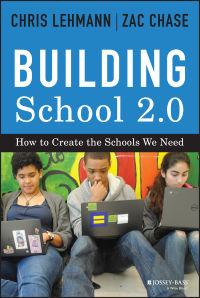First, this notion of personalization of learning removes student choice from learning what they most want to learn. It still assumes that kids have to learn everything we want them to learn. We don’t know how, in this era of high-stakes tests and corporate education “reform,” in which test scores are the profit-and-loss statements for schools, we can get away from this systemically, but we have to. And because language matters, we don’t think we should call self-paced tutorials real personalization. (It also isn’t necessarily anything new. The old Scholastic Reading Aptitude [SRA] learning modules did much the same thing in the 1970s; they just weren’t computerized.) We have to get to a place where we understand that, while there are skills and content that students do need to at least be exposed to, these “must haves” are probably far more expansive than they need to be right now. They are being taught at the expense of all kinds of other things that students could do, create, and learn that would ignite their passion and their minds in ways that mandated content consumption doesn’t.
Second, this model of “personalization” is still building off of a deficit model in which students are steered away from doing the things they are good at so they can focus on the things they are bad at. We have to move to a system where we create more space for students to play to their strengths while mitigating their weaknesses. Instead, we create system after system where kids are told to keep working on the things they are worst at. And then we wonder why kids don’t like school—or worse, think they don’t like learning.
Finally, too much of this model of “personalization” misses another highly personal piece of learning—the artifacts of learning we create when we learn. Students should be able to own their learning by creating stuff that matters to them. At SLA, we have seen students build biowalls, make movies, apply complicated mathematical concepts as they built trebuchets and robots, write and enact public action campaigns, and form book clubs around genre studies of their own definition. All of these examples are mapped to standards, all of these are ways for students to demonstrate mastery of the same concepts that we test on, but in ways that are truly personal to the student, because they choose them. That’s the model of personalization we want to see schools move toward.
From Theory to Practice
• Examine choice. Much of personalized learning touts choice. Evaluate this claim by asking whose choice students are making. If they are choosing one of a set of preplanned computerized choices or even from a limited list of teacher choices, then that’s not real choice. Build assignments for students that take learning as their goal, and provide students with the room to design and advocate for the choice of how that learning will be made manifest.
• Open the calendar. If students are choosing how they show their learning, it stands to reason that showcasing will happen on varied timelines. Set a deadline for when all submissions must be turned in and work with students individually to identify where in the calendar they’d like their individual product be completed.
• Use the other offerings for what they’re good for. If you have web access, it makes sense for your students to turn to sites like Khan Academy when they need another voice or medium for understanding content. When using these resources, avoid the danger of making them a lesser stand-in for deeper learning and teaching.

Chris Lehmann is the founding principal of the Science Leadership Academy, a progressive science and technology high school in Philadelphia. You can follow him on Twitter .
 Zac Chase is a former teacher, a consultant, and a writer who blogs at autodizactic.com and has contributed to several books including the bestselling Teaching Hope: Stories from the Freedom Writer Teachers and Freedom Writers Diary Teacher's Guide. You can follow him on Twitter .
Zac Chase is a former teacher, a consultant, and a writer who blogs at autodizactic.com and has contributed to several books including the bestselling Teaching Hope: Stories from the Freedom Writer Teachers and Freedom Writers Diary Teacher's Guide. You can follow him on Twitter .
Excerpted with permission from the publisher, Wiley, from Building School 2.0: How to Create the Schools We Need by Chris Lehmann & Zac Chase. Copyright © 2015.





 Zac Chase is a former teacher, a consultant, and a writer who blogs at
Zac Chase is a former teacher, a consultant, and a writer who blogs at